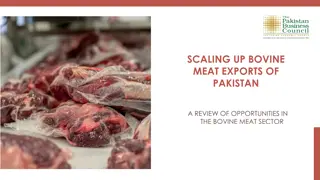Meat Hygiene Practices in Slaughter Methods
This informative content highlights the practical aspects of meat hygiene through different slaughter methods such as electrical stunning and captive bolt stunning. It discusses the techniques involved in ensuring animal welfare and achieving a humane slaughtering process. Detailed descriptions and images provide insights into the procedures and factors influencing the success of stunning methods.
Download Presentation

Please find below an Image/Link to download the presentation.
The content on the website is provided AS IS for your information and personal use only. It may not be sold, licensed, or shared on other websites without obtaining consent from the author.If you encounter any issues during the download, it is possible that the publisher has removed the file from their server.
You are allowed to download the files provided on this website for personal or commercial use, subject to the condition that they are used lawfully. All files are the property of their respective owners.
The content on the website is provided AS IS for your information and personal use only. It may not be sold, licensed, or shared on other websites without obtaining consent from the author.
E N D
Presentation Transcript
Meat hygine- practical Dr. measem hassan ali
Slaughter methods 1. Electrical stunning This is the most common stunning and slaughter application It works by producing brain dysfunction and unconsciousness with or without subsequent killing by cardiac arrest so that bleed out (exsanguination) is carried out consist of two type. a. Head-only electrical stunning Electrical currents, in sufficient quantities, applied on the head produce epilepsy ( grand mal or seizure-like state), spreading across parts of the brain stimulating other cells. This effect, characterised by rapid and extreme depolarisation of the membrane potential and development of a synchronised electrical response, can be measured and observed on the recorded electroencephalogram (EEG) as small waves with high amplitude in the tonic phase (rigid), and low frequency in the clonic phase (high motor activity in muscles) resulting in depression of electrical activity in pigs, sheep and cattle
b. Head-to-back (cardiac arrest) electrical stunning This method involves induction of an epileptic state in the brain with concomitant cardiac arrest by electrical currents applied in the chest. The idea behind this method is that animal welfare is maintained because any possible recovery is prevented as stopping the heart kills the animal. Additionally, convulsions caused by epilepsy are greatly reduced making carcasses more manageable hence improving operator safety.
2.Captive bolt (Mechanical) stunning This method , used correctly, can provide a satisfactory stun instantly meeting the main objective of stunning: to render the animal immediately unconscious . To maintain welfare the unconsciousness must be maintained until death without any recovery. Therefore, captive bolt stunning must either be irreversible or possible recovery must be prevented. It is mainly used in cattle, less frequently in sheep.
The following factors determine success of captive bolt stunning : Provision of a suitable gun with the correct strength in optimum working order Hitting the right target area (variations between species) Bolt velocity (at least 50 m/second) and impact on head Tissue damage Penetration Amount of energy (most important determinant) Gun type and condition, choice of cartridge/air pressure Carbon deposits built up inside the barrel must be brushed out.
Penetrating guns fire the bolt into the brain through the cortex, midbrain and brain stem
Non-penetrating guns deliver a blow on the skull damaging the cortex, midbrain and brain stem
3.Other stunning and slaughter methods Carbon dioxide Because conventional electrical stunning methods can have adverse effects on carcass and meat quality gas stunning methods have been introduced and used in the last 3 decades. Carbon dioxide, the principle agent, and inert gases such as argon and nitrogen can be used and pigs and poultry are the chosen species. Although cattle and sheep are not suitable for gas stunning due to size and presence of wool some recent trials in sheep have been carried in Spain successfully.
Water jet and air pressure High water jets developed for cutting and drilling in solid materials are available for use as stunners. Experiments to explore the suitability of water jets for stunning and killing purposes were conducted under laboratory conditions using post mortem materials (e.g. pig heads) and also on live slaughter pigs. Immediate unconsciousness as determined by EEG, was initiated by a rapid penetration of the skin and skull. In these studies destruction of the brain occurred within 0.2 to 0.4 s.
Other slaughter method Neck dislocation and neck cutting Heating Cooling down Fragmentation Magnetic stimulation
4.Halal slaughter slaughter is carried out by severing the neck to achieve instant and copious exsanguination using a sharp knife. The usual type of incision is transverse severance of the vessels in the retrograde fashion following an initial stab incision in the neck. Muslims believe that they are required to ensure rapid and maximum blood loss and that this is crucially important during and after Halal slaughter, because consumption of blood is forbidden. Effective exsanguination however, has been a source of concern in that in some cases occlusions can impede bleed out rate and delay loss of consciousness .Another claim was that stunning methods could impede blood loss during Halal slaughter.
Effects of religious slaughter on quality Carcass and meat quality The main potential effects of stunning and slaughter on carcass and meat quality . These are carcass defects such as haemorrhages, bruising, broken bones and more importantly rate and total bleed out, particularly in relation to religious slaughter without stunning. haemorrhages can be related to inappropriate pre slaughter handling, electrical stunning using high voltages with currents and sometimes due to possible nutritional or unknown factors such as blood splash in sheep. These defects and resultant downgrading can occur during slaughter with and without stunning. If electrical stunning is used before religious slaughter as long as sticking is done early enough, rising blood pressure may not be a problem
effects of electrical stunning and no stunning on meat quality in lambs. They are not differences in colour muscle ultimate pH (pHu), chilling losses and carcass weights after 45 min and 24hrs . The only effect was petechial haemorrhages in hearts caused by electrical stunning with 250 volts for 3 seconds. No carcasses with petechial haemorrhages, ecchymosis, haematomas or broken bones were found.
Blood loss and retention It is of utmost importance to expel as much blood as possible to meet religious requirements of Halal and Shechita slaughter. In addition to consumption of blood being forbidden, there are two beneficial reasons put forward, 1- harmful blood constituents would be excluded. 2- keeping quality of meat would improve. 3- The basis for better keeping of meat was that blood would provide a good medium for bacteria to grow. 4- Another consideration is that if blood is left in vessels, after cutting, it could produce an unsightly appearance. 4- However, it has been shown that minced meat mixed with blood and inoculated with bacteria showed no more growth of included bacteria than meat that had no added blood . 5- Nevertheless, although it is impossible to rid a carcass of its blood completely as there will be some retention of blood, efforts need to be made.
6- the stunning would adversely affect bleed out rate and total loss and that neck cutting without slaughter improved blood loss. 7- measured blood haemoglobin content in different muscles as an indicator of bleed out quality. 8- blood parameters, colour and pH were measured in different species slaughtered by Shechita or Halal or conventional methods showing no difference. 9-sticking and blood loss could still be better after Shechita( halal saulghter) because of the very sharp knife used and efficacy of cut.























